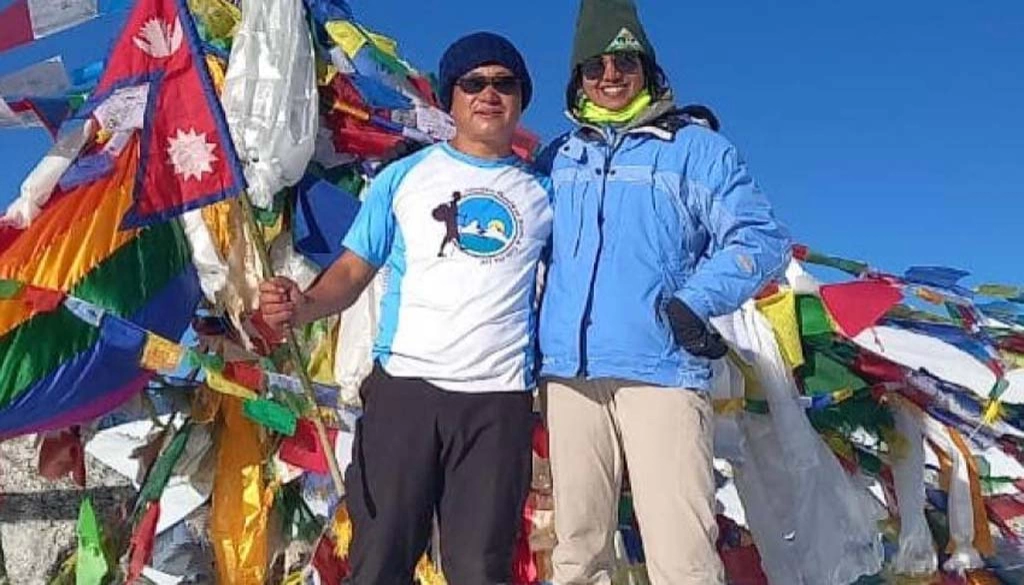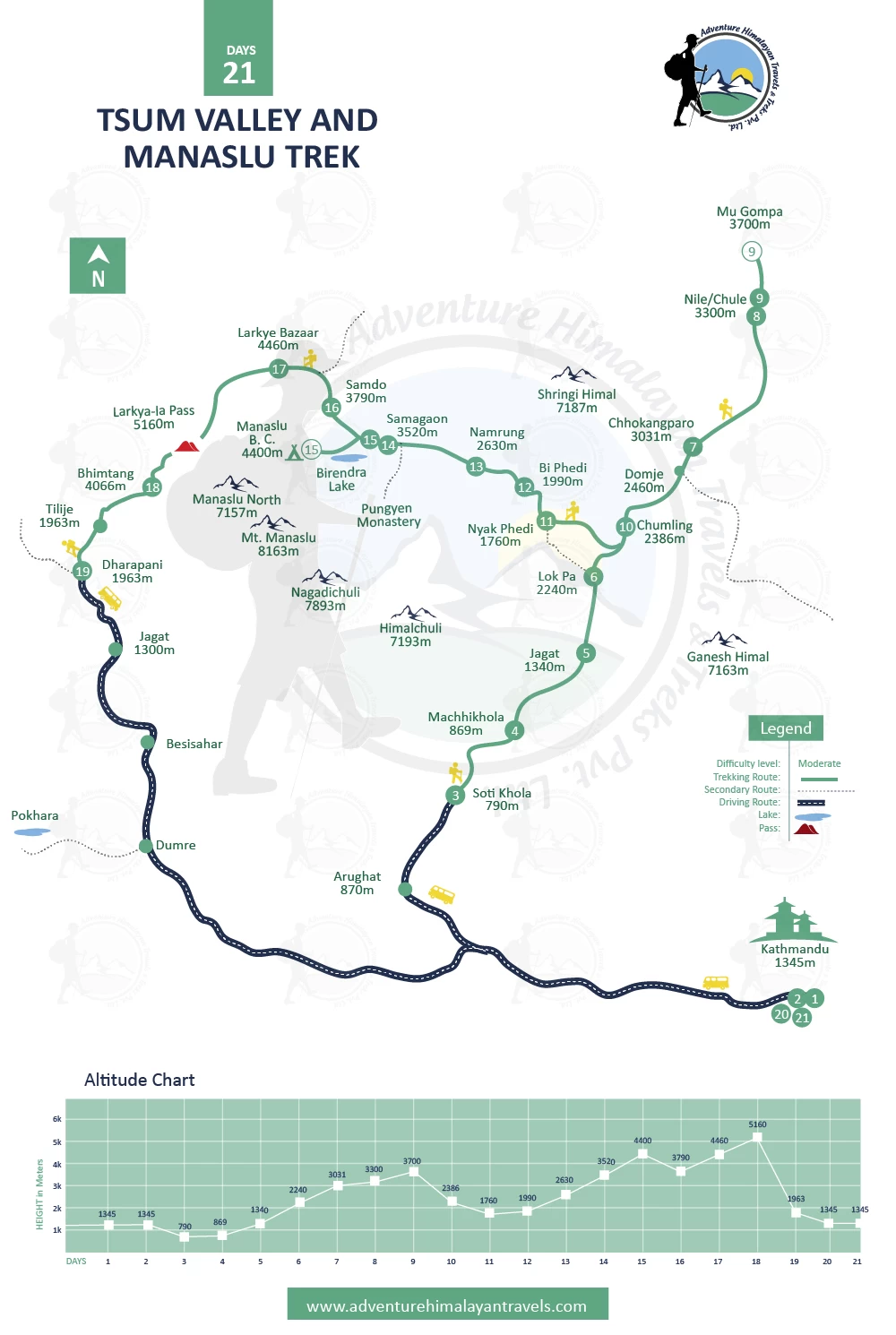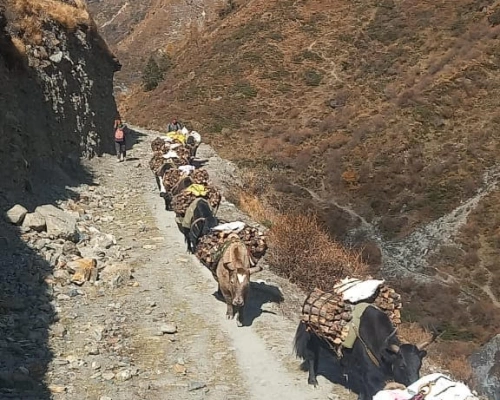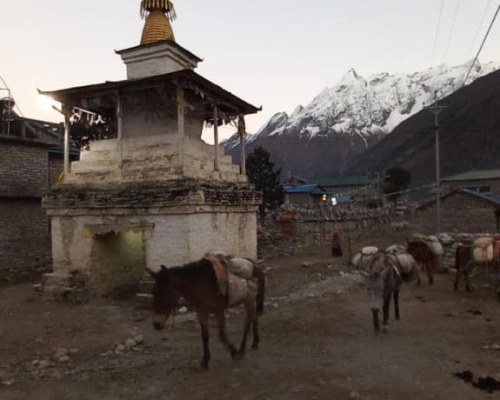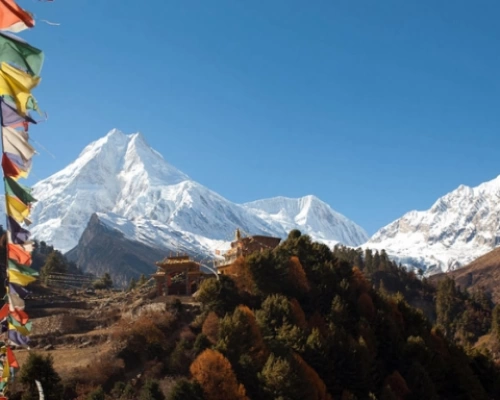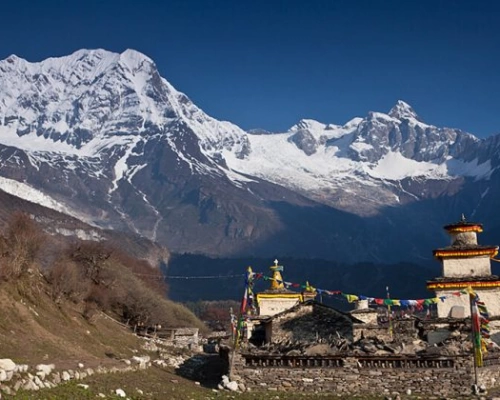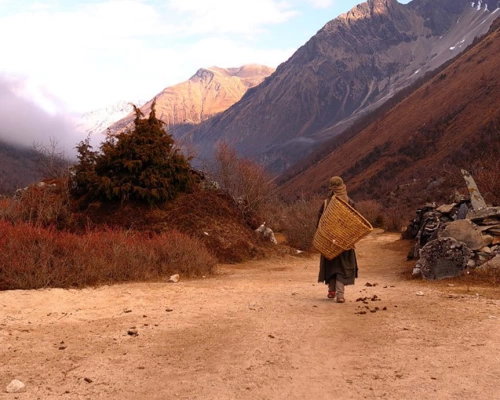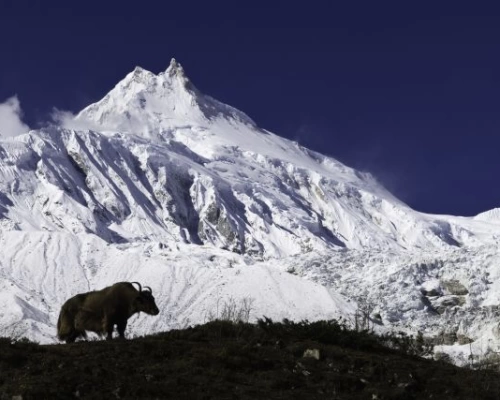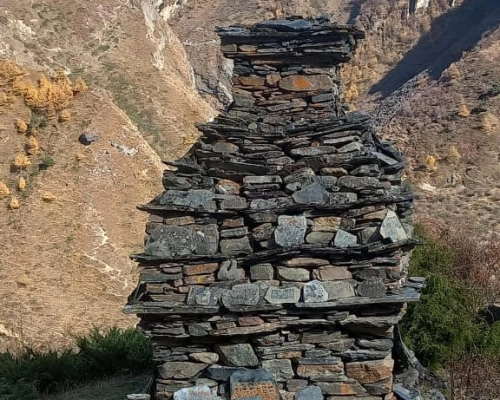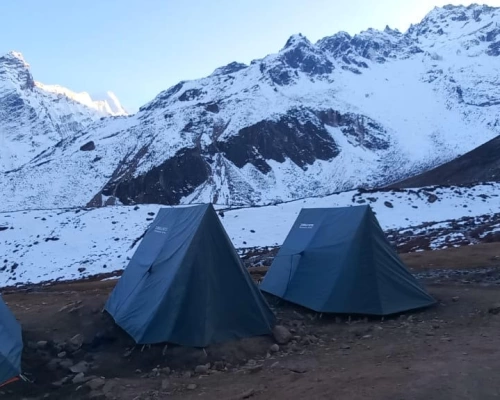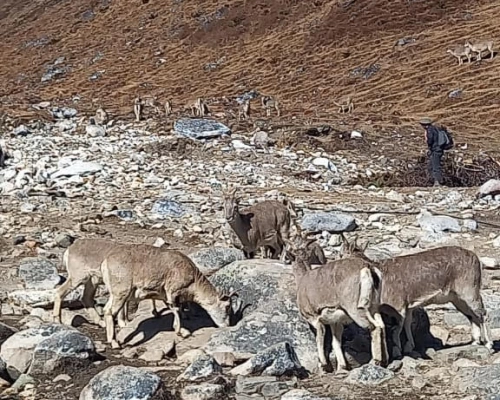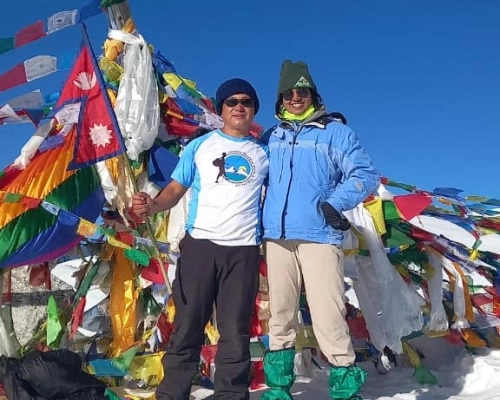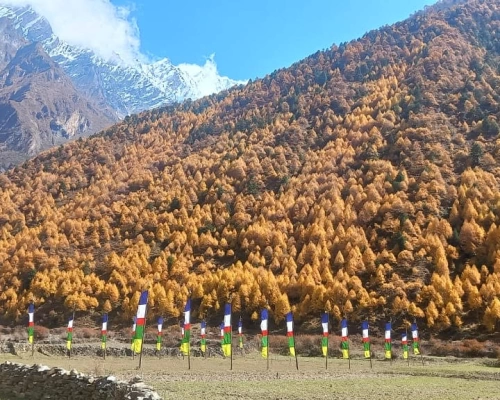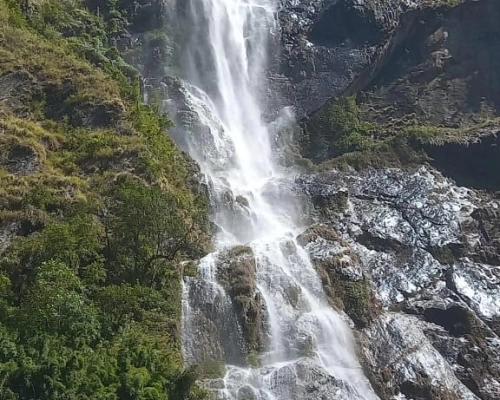The valley created by draining the Shear Khola originated from the western glacier of Ganesh Himal and glaciers of Sringi Himal to the east and south, meeting at the Budhi Gandaki at Nyak, is ‘Tsum’ which is abundant in nature with several rare wildlife under protection with the strict prohibition of hunting and fishing, especially the Himalayan Thar and Blue sheep, which congregate in herds of 50 to 200. The valley boasts some of the unique and historic monasteries, such as Rachen Gumba and Mu Gumba, lying on a pretty plateau nestled in the lap of the valley, and Lungdang Gumba on a conical base hill, as the town has a long history of Buddhism that begins with the meditation of the Buddhist saint Milarewa in the caves of the mountains encompassing the valley.
Traditionally, the valley was a culturally distinct geographical area called "Tsum Tso Chuksum", meaning thirteen provinces ruled as a single territory. The ancient remains of the Tsum Kingdom are still visible today. Due to its remoteness and inaccessibility, this sacred valley and its people have been bypassed by mainstream development for centuries. As a result, the unique culture of this valley has remained intact. Therefore, the Tsum Valley and Manaslu Trek are one of the best off-the-beaten-path treks in Nepal, bordered by two major river systems: the Budhi Gandaki to the east and the Marshandi Khola to the west. The biggest attraction of this trek is undoubtedly Baudha Himal, Gorkha Himal, and Himal Chuli, including the spectacular Manaslu range and the Annapurna ranges, combined with the forest and wildlife along the ridge.
The route begins in Gorkha and follows the rugged gorge of the Budhi Gandaki River through the native Gurung communities with large Buddhist monasteries, which can be seen from the upper reaches of the river. Initially, a few days of the trek move along the Marshyangdi through communities predominantly composed of Gurung and a sizeable number of Brahmin. One of the highlights of this section is the numerous high waterfalls cascading down into the main river while the valley rises slowly with a rare chance of acute mountain sickness (AMS). After four days on the trail, the river changes course and flows from the south while the landscape shifts to steep, rocky gorges with large stands of pine covering the forest that passes by several ancient temples representing the pre-Buddhist Bon religion.
Whereas, the diverse geographical and climatic region has led to a wide variety of flora and fauna with heavily cultivated landscapes with terraced paddy fields and rolling hills that are famous for their winter crops of oranges, freshly harvested from the trees along the trails in the foothills, while the landscapes in the rain shadow area to the north of the mountains are barren, being extensive south of the Tibetan plateau. As you progress higher up into the hills, the natural vegetation changes from tropical species to more temperate stands of forest trees including oak, beech, and rhododendron that give way to coniferous forests of pine and, ultimately, juniper just below the tree line. A large variety of animals are in sight, including the barking deer and Himalayan marmots above the tree line and exclusive pheasants, as well as all the usual alpine birds along with ravens and coughs just below the tree line.
The trekking in this region is going to be slightly more challenging than normal treks, precisely during sudden snowfall while crossing Thorong La Pass, which can be completed in a minimum of fifteen days, starting in Kathmandu and finishing in Pokhara. So, potential trekkers must be well prepared and equipped for all events, allowing a few days extra to enjoy several possible side trips and add immeasurably to the experience.
What to expect from Tsum Valley and Manaslu Trek?
The Tsum Valley and Manaslu trekking trail are geographically and culturally swanky regions in Nepal that let you snuggle with Mother Nature and its Himalayas with radiant mountain views, picturesque landscapes, beautifully oriented terraced hillsides, gushing canyons, and the authentic Tibetan culture that originated all below the Larkya La High Pass.
The trek is throughout the river valleys of the Budhi Gandaki and Marsyangdi rivers, which still showcase ancient Vajrayana Buddhism coexisting with Hinduism, as interpreted by several monasteries, gompas such as Mu Gompa at an altitude of 3,700 m, numerous Chortens, and Mani walls that are watched over by the majestic ranges of Ganesh Himal, Singri, and Boudha Himal, which are dominated by the eighth highest peak in the planet, Mt.Manaslu (8,163m).
During your trek to the isolated natural and cultural fascination of the Manaslu region, you will get to pass by several exciting dense forests that are home to diverse flora and fauna some endangered listed species as well. Expect:
The unique people and culture of the Tsum Valley Manaslu
The restricted Tsum Valley, which was opened for trekkers and travelers only in 2008, is yet another raw Himalayan area, still hidden and mysterious, and home to distinctive cultures and traditions.
The locals from the Tsum prefer calling themselves Tsumbas, the people from ‘Beyul Kyimolung’ or people from the Valley of Happiness, as translated from the local language. They inhabit the typical stone-built, intricately carved Tibetan houses.
Although their architecture, culture, traditions, socio-norms, values, and religion showcase an uncanny Tibetan influence, the locals have their dialects, costumes, and distinguished way of regulating life and have kept it alive till today away from the massive modernization.
They celebrate the Tibetan New Year, Lhosar, when the beautifully dotted ancient monasteries look extra vibrant, adorned with new prayer flags, usually in February or March. The Mani walls, chortens, and gompas at this time add immense beauty to the whole region.
On the way to trek the Manaslu, you will get to savor the extraordinary cultural and traditional presentation while you pass by the historical Tsum Valley, which once was an important trade route between Nepal and Tibet.
Cross the longest Mountain Pass in Nepal, Larkya La Pass (5,106m)
The maximum altitude you will reach in the Tsum Valley and Manaslu Trek is the Larkya La Pass, at 5,106 m (16,748 ft) above sea level. Being the longest high mountain pass in Nepal, like any other mountain pass, it also conceals the Manaslu Trekking Region and its valleys from the hustling and bustling world.
Though the Larkya La Pass isolates the Manaslu region's valleys and its beauty from the rest of the world in the serenity of the dominating eighth-highest mountain in the globe, Mt. Manaslu (8,416 m), it connects the major mountain villages of Dharamshala and Bimthang with incredible mountain vistas of the Himlung Himal, Annapurna II, Cheo Himal, and many others.
The dramatic pass is outstandingly rewarding when you get to make it through it safe and sound via the tough, rugged terrain, chilly Himalayan wind, and steep ascents and descents that are intriguing but at the same time the most stunning, once-in-a-lifetime scenery.
That is why Larkya La is considered the ultimate challenge as well as the most mythical sight of the Manaslu trek through the valley of Tsum, which provides you with impressively varied landscapes, encounters with rare Himalayan flora and fauna, and the unspoiled culture and tradition of the locals.
Witness the beauty of Buddhism in Tsum Valley and Manaslu Circuit Trek
The Tsum Valley in the Manaslu region, Gorkha District of Nepal, on the way to the Manaslu Circuit Trek, is an amazing sacred Himalayan valley almost completely untouched by modernization.
The valley is culturally, historically, and naturally flourished with ancient monasteries, gompas, chortens, and mani walls dedicated to the lord Siddhartha Gautam Buddha, demonstrating the locals' deep connection to Buddhism.
The majority of the Tsumbas are active practitioners of Vajrayana Buddhism and perform daily rituals by visiting several monasteries in the valleys, such as Ranchen Gompa, Mu Gompa, and Gumpa Lungdang Nunnery.
They are artistically carved and hold substantial religious and historical values dating back to centuries when the Buddhist saint Milarepa is believed to have obtained liberation by medicating in the cave of Milarepa.
It all has nourished the most hospitable, welcoming, and smiling people of the Manaslu region, who are capable of thriving hard even on that rural continent of the Himalayas.
Trek Tsum Valley and Manaslu circuit in Monsoon of Nepal
Often, the monsoon season in Nepal, spanning from June to mid-August, is considered to be off-trekking season. Most of the trekking region at this time observes heavy showers, muddy and slippery trails, and leeches above 2,400m.
The weather in the summer/monsoon season is rainy throughout the day and night and obstructs visibility, adding more to the difficulties of the trek. However, Tsum Valley and Manaslu Circuit lie in the west central rain shadow area of Nepal and are the best off-beaten paths to explore, even in the monsoon months.
It barely even drops, yet the whole Manaslu region at this time comes with the excellent greenery of the surrounding hills, verdant woods, roaring rivers, cascading waterfalls, and mind-blowing scenery.
While trekking in other regions than Tsum Valley and Manaslu is also possible in the monsoon with careful selection of extra gear and equipment, Tsum Valley and Manaslu remain the best options for more convenient and hassle-free trekking in the Himalayas of Nepal.
The safest, least-trodden trekking trail in Tsum Valley and Manaslu Trek
The trekking route to Tsum Valley and Manaslu Trek is undoubtedly less crowded and involves crossing the challenging Larkya La Pass (5,106m). Yet, it is one of the safest trekking trails in other regions of Nepal, comparatively, with a lower probability of altitude sickness.
On the other hand, unlike other high mountain passes in Nepal, where climbing the pass can be compulsory and requires climbing gear and equipment, the overall Tsum Valley Manaslu Trek is a teahouse trekking experience to enjoy without having to put extra thought into camping gear and climbing equipment.
In addition, there are a minimum or not at all chances of seeing blizzards or glacial slides, and you will not be spending the trek nights at the highest altitudes like in the Annapurna or Everest Base Camp Trek.
Therefore, the Tsum Valley and Manaslu Trek is a less-trodden yet safest trekking route within the Manaslu area of Nepal.
Tsum Valley Manaslu Trekking Itinerary
The Tsum Valley Manaslu Trekking itinerary can be extended or shortened as per the individual preferences and time restrictions of trekkers, which usually spans around 17 to 21 days.
The Tsum Valley Manaslu Trek itinerary set by Adventure Himalayan Travels and Treks is of standard 21 days, which includes ample time for adequate acclimatization and considering varying mountainous weather.
The trek officially commences from Soti Khola, which later on follows the trail to Maccha Khola, Jagat, Lok Pa, Nile, and Mu Gompa and then heads to the Manaslu Base Camp by Nyak Phedi, Bi Phedi, Namrung, and Sama Goau, and traces the way back to Kathmandu via Sando, Larke Pass, Bhimthang, Tilije, Dharapani, and Besisahar.
Tsum Valley Manaslu Trek Cost
The Tsum Valley and Manaslu Trek cost depend mostly on your specific selection of itinerary, trek duration, season, mode of transportation used for the trek, and special services you have chosen to relish during the trek.
Nonetheless, to the great delight of Tsum Valley Manaslu aspirants, you will be granted a surreal trekking experience. At the same time, you trek Tsum Valley Manaslu at an affordable cost according to the budget plan and trek cost customized by one of the most reputed travel, tour, and trekking organizers, Adventure Himalayan Travels and Treks.
We are offering discounts on groups, which are USD 1,790 per pax (a group of two people). In general, the cost of the Tsum Valley Manaslu Guided Trek is:
- USD 1,790 for 1 pax
- USD 1,675 for 2-3 pax
- USD 1,625 for 4-6 pax
- USD 1,575 for 7–10 pax
This package covers all the expenses of food, accommodation, transportation, and guides during the trek, including their insurance, expenditure on lodging, and food.
